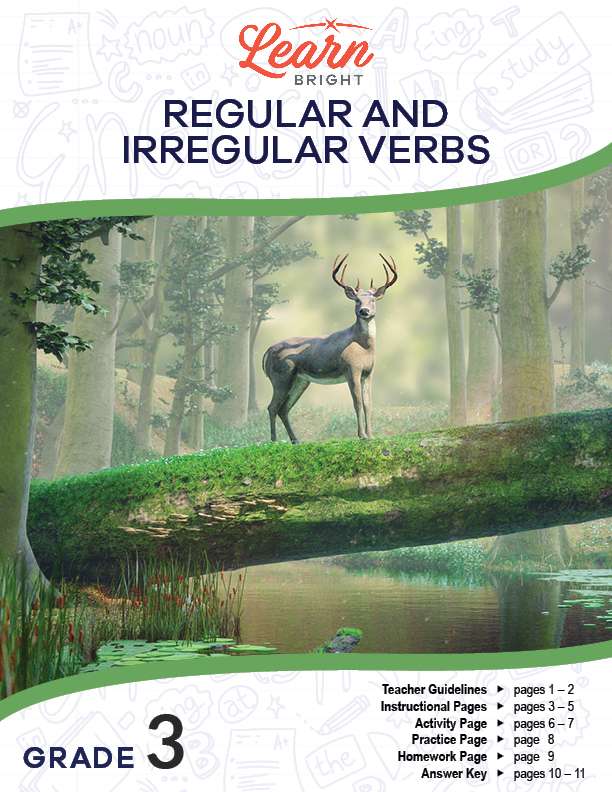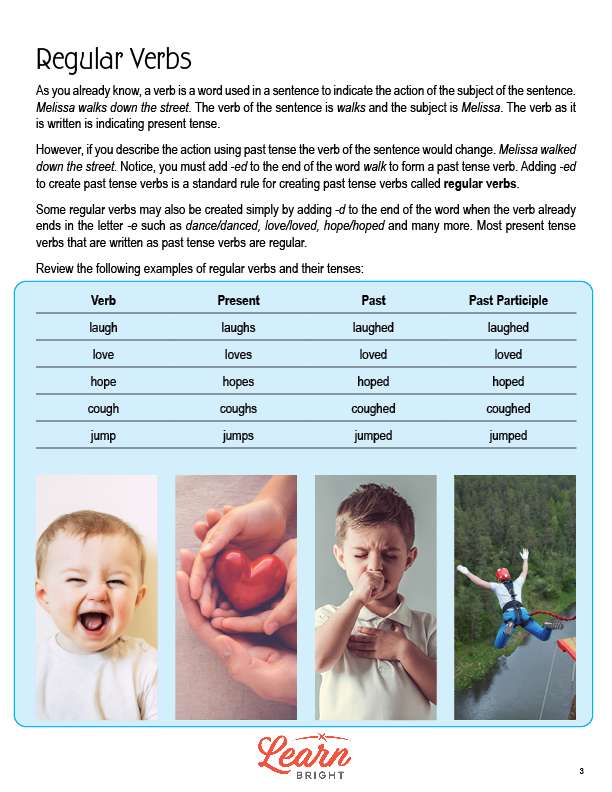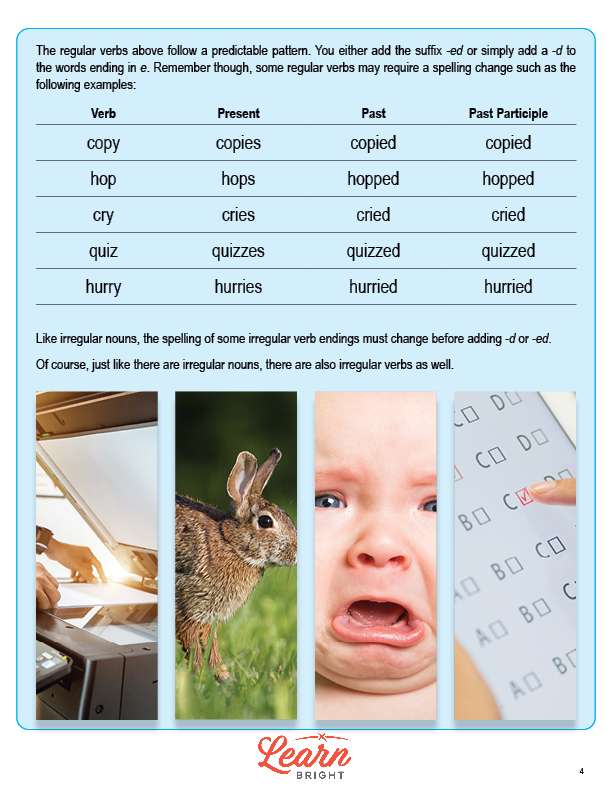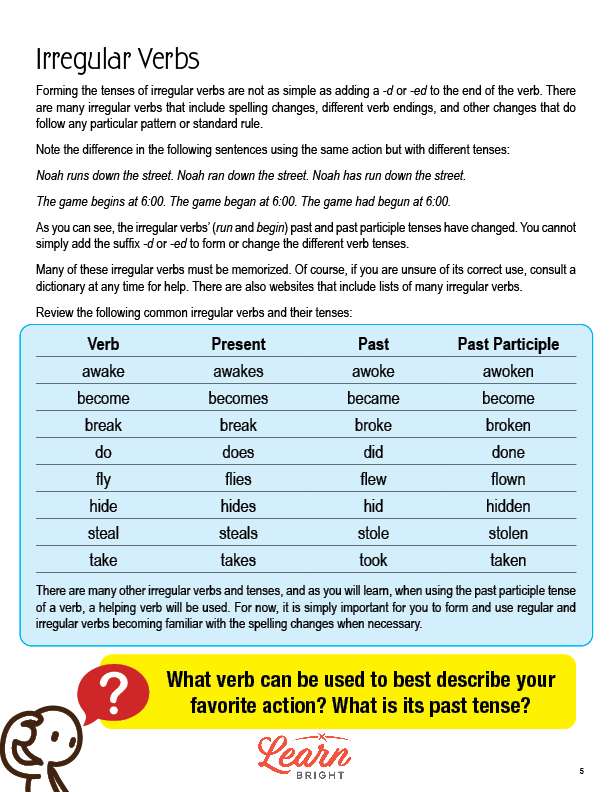Description
What our Regular and Irregular Verbs lesson plan includes
Lesson Objectives and Overview: Regular and Irregular Verbs teaches students about both regular and irregular verbs, including what they are and how we use them. At the end of the lesson, students will be able to form and use regular and irregular verbs. This lesson is for students in 3rd grade.
Classroom Procedure
Every lesson plan provides you with a classroom procedure page that outlines a step-by-step guide to follow. You do not have to follow the guide exactly. The guide helps you organize the lesson and details when to hand out worksheets. It also lists information in the green box that you might find useful. You will find the lesson objectives, state standards, and number of class sessions the lesson should take to complete in this area. In addition, it describes the supplies you will need as well as what and how you need to prepare beforehand. To prepare for this lesson ahead of time, you can put students into groups for the activity and copy the handouts.
Options for Lesson
Included with this lesson is an “Options for Lesson” section that lists a number of suggestions for activities to add to the lesson or substitutions for the ones already in the lesson. One optional adjustment to the lesson activity is to either increase or decrease the number of words. You can also have your students write sentences for the activity instead of conducting a conversation. An optional addition to this lesson is to have your students use current reading or other content and identify regular and irregular verbs. Finally, you could have your students write three short 5-sentence stories: one in the present tense, one in the past tense, one using only past participle verbs with helping verbs.
Teacher Notes
The teacher notes page includes a paragraph with additional guidelines and things to think about as you begin to plan your lesson. It notes that you should show students a more extensive list of irregular verbs than the ones included in this lesson. This page also includes lines that you can use to add your own notes as you’re preparing for this lesson.
REGULAR AND IRREGULAR VERBS LESSON PLAN CONTENT PAGES
Regular Verbs
The Regular and Irregular Verbs lesson plan includes three content pages. Verbs are words that we use in sentences to indicate the action of the subject or the sentence. For example, in the sentence Melissa walks down the street, Melissa is the subject and walks is the verb. This verb is in present tense.
You can also describe the action using the past tense of a verb, like Melissa walked down the street. In this case, you add -ed to the verb to make it past tense. This is a standard rule for creating past tense regular verbs.
You can also create some regular past tense verbs by adding -d, if the verb already ends with an e, like love/loved and hope/hoped. Most present tense verbs are regular in the past tense.
The lesson lists some more examples of regular verbs and their tenses, including laugh/laughs/laughed/laughed and many more.
These regular verbs follow the same pattern. You add -ed or –d. However, some other verbs require a spelling change. Some examples of this include copy/copies/copied/copied and hop/hops/hopped/hopped. You must change the spelling of some irregular verb endings before adding -ed or -d. We have irregular verbs just like we have irregular nouns.
Irregular Verbs
Forming past tense irregular verbs is more complicated than adding an -ed or -d to the end of the verb. Many irregular verbs need spelling changes, different verb endings, and other changes that don’t follow a predictable pattern.
You can see some of these changes in the following example: Noah runs down the street. Noah ran down the street. Noah has run down the street.
Runs becomes ran or run. You do not add an -ed or -d to form the past or past participle versions. You need to memorize many of these irregular verbs because they don’t follow a pattern. Of course, you can always check in a dictionary or look on the internet for help.
The lesson closes with a list of some irregular verbs in their present, past, and past participle forms. Two of these examples are awake/awakes/awoke/awoken and become/becomes/became/become.
REGULAR AND IRREGULAR VERBS LESSON PLAN WORKSHEETS
The Regular and Irregular Verbs lesson plan includes three worksheets: an activity worksheet, a practice worksheet, and a homework assignment. You can refer to the guide on the classroom procedure page to determine when to hand out each worksheet.
CONVERSATION ACTIVITY WORKSHEET
Students will work in groups to complete the activity worksheet. Each group will conduct a conversation where they use each verb in the order the worksheet lists them. They will try to connect their sentences and make them make sense as a conversation.
Students can also work in pairs to complete the activity.
FILL IN THE BLANKS PRACTICE WORKSHEET
For the practice worksheet, students will fill in the blanks in a chart that lists verbs and their present, past, and past participle forms.
REGULAR AND IRREGULAR VERBS HOMEWORK ASSIGNMENT
The homework assignment asks students to first correctly fill in the blanks in a chart that lists verbs and their present, past, and past participle forms. They will then write sentences using the given past participle verbs, making sure to use helping verbs.
Worksheet Answer Keys
This lesson plan includes answer keys for the practice worksheet and the homework assignment. If you choose to administer the lesson pages to your students via PDF, you will need to save a new file that omits these pages. Otherwise, you can simply print out the applicable pages and keep these as reference for yourself when grading assignments.










